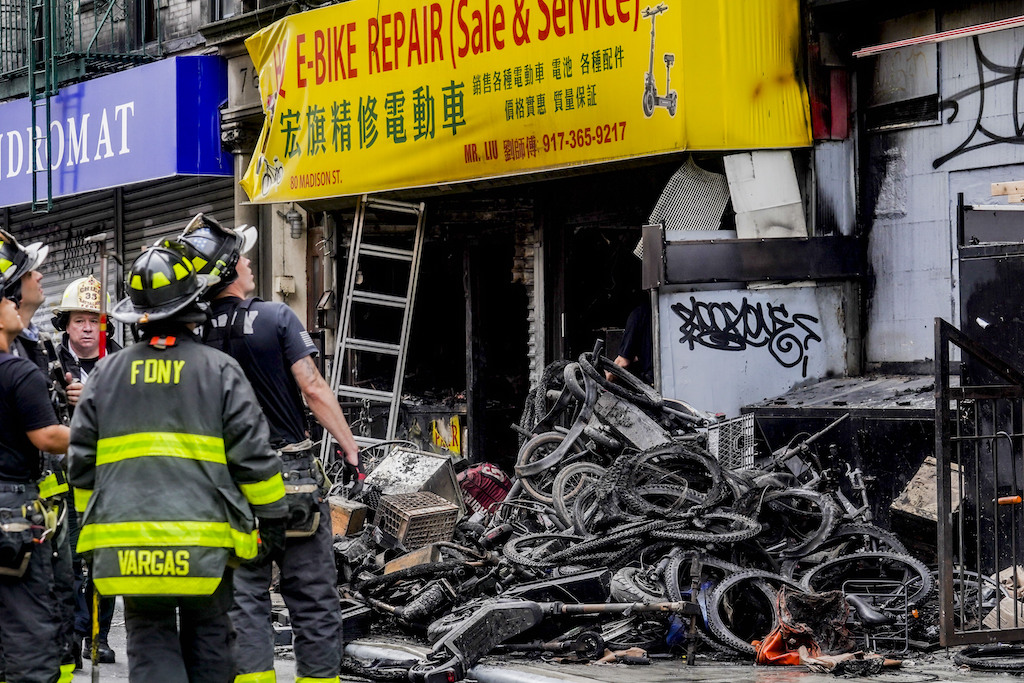E-bikes are one of the least-known issues facing New Yorkers at present; few people are aware of just how dangerous they are. The problem is so severe that a fire marshal of the Fire Department of the City of New York (FDNY) called on the U.S. Congress to pass federal-level legislation regulating lithium-ion batteries that enter the city from outside. But what exactly is the issue? How did it arise? Why is it relevant? What can be done to fix it?
The dangers of e-bikes have been exacerbated by the rise of food delivery platforms such as Doordash and GrubHub. The delivery people often use e-bikes to get around. Some end up parking them on the sidewalks in front of restaurants and the buildings they deliver to — which is an inconvenience for those walking by. Moreover, they often ride on sidewalks with little regard for pedestrian traffic and safety; this behavior is rather unsafe and has definitely distressed this writer once or twice.
Pedestrian safety risk, while problematic, is by far the most benign issue e-bikes cause in New York City. The issue of lithium-ion battery fires is not a recent development. The first severe fires were reported in 2010, and since the problem has only worsened. In 2023 alone, there were 268 fires caused by lithium-ion batteries, which killed 18 people and injured 150. So far in 2024, there has been one fatal fire which killed a 27-year-old journalist in Harlem and injured 17 others. This number will only increase as the year continues.
Why are lithium-ion battery fires so lethal and pervasive? Legislation, or rather a lack thereof, has enabled them. E-bikes and e-scooters are generally illegal, but not criminalized, which means their manufacture is not regulated. This lack of enforcement allows manufacturers to make the batteries as cheaply as they want with zero regard for safety or potential consequences. Furthermore, a very common practice for owners is going to makeshift battery repair shops to save money on a new battery. As a result, the mended batteries are incredibly shabby so they will explode if poked somewhat forcefully with a stick. Additionally, owners will often charge their battery packs overnight with little to no supervision, and because overcharging leads to overheating and likely an explosion, many lithium-ion battery fires occur overnight. The cheap, cost-cutting production combined with the lack of knowledge most owners of e-bikes and e-scooters possess is really what makes e-bikes a menace. These batteries take mere seconds to ignite, and they do so violently. When battery packs explode, they don’t simply combust at once. Often up to 25% of the battery cells will become projectiles and shoot across the room. The issue is even worse when fires start in e-bike stores. When one battery pack starts to burn, even the ones farthest away from it can be affected and damaged. One incident occurred in June 2022 in Chinatown when an e-bike combusted in an e-bike store and the fire spread to basically every bike throughout the store. Four people were killed, and the fire reignited the following day, causing even more hassle for the companies that responded.

Fires like that one illustrate the unpredictability of lithium-ion battery fires, which can’t be extinguished with water due to how hot they burn. They burn at upwards of 3,600 degrees Fahrenheit, so using water could lead to a hydrogen gas explosion, which is less than ideal. They also can’t be effectively extinguished with the fire extinguishers found in most homes, which are usually dry chemical ABC. The inefficacy of these common fire suppressants makes e-bike fires exponentially more difficult to fight, and more often than not they require a special call of the FDNY hazardous materials unit, which, despite being a special unit that should logically not be very busy, went on 1,191 calls in 2023, of which 193 were fire emergencies. It would be foolish to assume that the bulk of those fire emergencies were anything but lithium-ion battery fires, given their prevalence throughout New York City.
It is incredibly easy to compromise poorly made lithium-ion batteries to the point of explosion, including by getting them wet, hitting them or otherwise forcibly changing their form, or exposing them to heat. Besides the obvious physical dangers, lithium-ion battery fires pose additional health risks when they burn. They release a profuse amount of smoke, but far worse, they release hydrofluoric acid, which causes permanent lung damage after just one breath.
Many places afflicted with lithium-ion battery fires are significantly impoverished. The median incomes of the twelve hardest-hit zip codes averages out to nearly $25,000 less than the city median and nearly $30,000 less than the state median. A lot of delivery drivers are fairly poor, and some are even undocumented, and so many live in poorer neighborhoods. The highest concentration of lithium-ion battery fires in the city from January 2021 to November 2022 occurred in the Queens neighborhood of Corona, which reported a total of fourteen fires, or about one every six weeks. This area has a high working-class population — a statistic common among areas with significant lithium-ion battery fire problems.
The engine and ladder companies responsible for this area, Engine Companies 324 and 287 and Ladder Company 136, are not the busiest companies in the city, but they are certainly not restful. Engines 287 and 324 each had around 4,500 responses in 2023. Ladder 136 ran almost 3,300 times.
These companies are under the purview of the 46th Battalion, which is responsible for the region where the largest number of fires occurred. The battalion chief of the 46th Battalion responded to over 3,800 calls in 2023, including 787 fires.

Members of Engine 324 and Haz-Mat 1 were asked a series of questions regarding lithium-ion batteries and the dangers they pose in daily usage in New York City._ Universally, the sentiment was that lithium-ion battery fires are very destructive, very dangerous and very preventable. The advice they gave was to never buy batteries from anywhere but the manufacturer and to make sure the batteries are not just approved but intended for your product. They mentioned that storing batteries inside is also very dangerous. Many people store their e-bikes and e-scooters by their front door so they don’t have to carry them very far into their house or apartment, but if these devices catch fire, the primary means of egress is blocked almost instantly given how quickly lithium-ion batteries go from zero to violent explosion.
The issues with lithium-ion batteries are not limited to e-bikes and e-scooters. The vast majority of cell phones, tablets, and laptops also use them because they are inexpensive to produce, lightweight, and extremely powerful. But because mobile devices are legal, their batteries are regulated, making them much safer than e-bike batteries. This does not mean that they are guaranteed to be 100% safe, however. In a world where complacency causes catastrophes, like many lithium-ion battery fires, one must always exercise caution when charging personal devices. It is not recommended to charge them unsupervised overnight or in a manner that blocks heat from escaping — this is very dangerous, as the driving factor behind battery fires is heat. In general, it is a good idea to be aware of the potential dangers of negligence when it comes to lithium-ion batteries, which can and do explode without even being overheated or poked somewhat forcefully with a stick. Fire can strike without warning. Don’t give it a chance.























